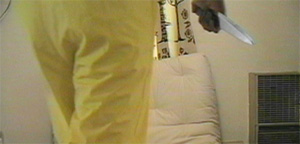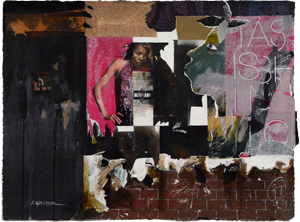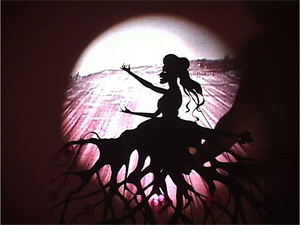No Rest for the Weary
John Haberin New York City
Rodney McMillian, Tenses, and Larry Walker
Rodney McMillian might be setting himself up for failure. Failure has become something of an obsession, in fact, for an artist who seemed destined for success. So, too, has disturbing sleep.
McMillian portrays city streets as abandoned furniture, used bedsheets, and battered vinyl. Blackness for him takes more shapes than a white artist might ever know. Should it matter that some of them come way too easily? His midcareer retrospective spans two cities, two boroughs, and three museums, as if art could no longer contain blackness. Perhaps it never could. Meanwhile the artists in residence in "Tenses" at the Studio Museum in Harlem ride the roller-coaster, and Larry Walker looks back on decades of art and teaching by running up against a wall. 
Disturbing sleep
Barely ten years ago, Rodney McMillian was an emerging artist in "Frequency," at the Studio Museum, where his latex spilled out onto the floor. More sagging black vinyl appeared in the 2008 Whitney Biennial and at the Studio Museum in "The Bearden Project" in homage to Romare Bearden and The Block, where a full moon shined through. He seemed just as sleepless at the Brooklyn Museum, in a show of art and civil rights. His homage to Nat Turner took him on a walk in the woods for only six minutes, but long enough to take day into night. Maybe a failed slave rebellion had to mean more to a black man who left South Carolina for Southern California. Or maybe he just cannot give it a rest.
He defied a resting place again on video in 2012, reducing a futon to an empty shell to tie up and throw away. It also scattered cotton to the floor, as the harvest of African American history. Bits and pieces of all those themes and media appear in "Views of Main Street" at the Studio Museum, looking all the more ineffectual. This Main Street has its sofa, but cut in two by cement, and its chairs, but separated by a pile of books. Maybe the more he learns, the harder it is to hold a conversation. Other books turn up in a photograph, as his provocative choices.
A battered rug already hung on the wall in "Into Me / Out of Me," at MoMA PS1 in 2006. Carpeting appears again in red as well, as if not even fit for treading underfoot. It has an affinity with bloodied fur, feathers, and body prints from David Hammons. McMillian has more of the older artist's anonymity now, too, with videos of not performances but puppet shows. Stephen Westfall speaks for him in a third, delivering LBJ's speech introducing the Great Society with a youthful energy and a condescending smile. A photograph of the Supreme Court breaks up into mountains, sea, or sky—like the Constitution's promise, both glorious and always in doubt.
The spill extends to Queens for a room of "Landscape Paintings" at MoMA PS1. They take the form not of quiet yards and interiors as for Lois Dodd, but of leftover paint on old bedsheets, governed by little more than gravity. Do they represent spilled blood, art that has long since run its course, or (as the museum suggests) "an abject history of turmoil"? Does the brief video of McMillian beneath a bare sheet represent a ghost, a struggle, a modern dance, or a toga party? Does it add up to too many ghosts, too many threats, and too many directions? What about his vinyl in "The Black Show" (which I have not yet seen), at the Institute for Contemporary Art in Philadelphia?
The Studio Museum includes vinyl, too, among its twenty works, compressed to the dimensions of a hoodie or a mirror. This is painting as beaten down and black. At the same time, it recovers agency for the artist. Something of that dynamic appears as well in another piece of furniture, an armchair impaled by a large black tube. It does not appear half as clearly in more flooring on the wall or a damaged refrigerator. With work so all over the map, the show risks making it hard for much of anything to appear at all.
Compared to those twenty-five minutes with a spare mattress, McMillian seems to be working a lot less hard. Pinocchio and a suspiciously friendly lizard play their part as puppets, both with Lee Atwater's racist words. Atwater is way too easy a villain, and Pinocchio has way too empty a smile. The fridge has too little value added, Westfall too obvious a smirk. Midcareer is a bad time for an artist this promising to be marking time. Maybe the retrospective, like his standout role to come at the 2022 Whitney Biennial, will free him up to resume the struggle.
Rising artists?
Tired of the roller-coaster ride that tastemakers call the art world? For artists, the only thing worse is not getting an admission ticket. It can only help, then, that each year the Studio Museum in Harlem takes the trouble to wrap up the tenure of its artists in residence with an exhibition, something coming only belatedly to Open Sessions at the Drawing Center. And it only makes sense that its 2016 edition, "Tenses," has at its center a roller-coaster. Is it a working roller-coaster? Not exactly, but that only makes sense, too.
 One might think otherwise from the wall text introducing the show. It describes E. J. Hill as between sculpture and performance, with a stage on which the artist can position himself riding the rails. The work says otherwise, but by its end the ride has become the viewer's. The sculpture stakes out a long oval, no more than waist high and site specific to the museum's mezzanine. It also appears as minimal, massive, and glowing. Hill constructs its support from an open lattice of light wood and its curving tracks from LEDs.
One might think otherwise from the wall text introducing the show. It describes E. J. Hill as between sculpture and performance, with a stage on which the artist can position himself riding the rails. The work says otherwise, but by its end the ride has become the viewer's. The sculpture stakes out a long oval, no more than waist high and site specific to the museum's mezzanine. It also appears as minimal, massive, and glowing. Hill constructs its support from an open lattice of light wood and its curving tracks from LEDs.
Summer sculpture by Martin Puryear, in Madison Square Park, may also recall a roller-coaster. And Puryear gets the art world dead on, not least for an African American, with a colossal rise and sudden fall. Hill's ride looks more inviting, enough that one can almost overlook the risks. At its far end, though, a stage does appear, with evidence of a fall. A young black male lies there, in death or a tormented sleep. One can wait a long time for him to move.
The Studio Museum can be proud of its yearly dedication to studio artists—as with Leslie Hewitt in 2008, "Scratch" in 2005, "Usable Pasts" in 2010, "Evidence of Accumulation" in 2011, "Things in Themselves" in 2013, Everything, Everyday" in 2014, last year's "Material Histories," or "(Never) as I Was" coming up. It also surveys emerging artists every five years, most recently in 2013 with "Fore.") This year's ride, though, gets off to a slow start. Jordan Casteel leans to Harlem street portraits, much like Barkley L. Hendricks or Gordon Parks, with the emphasis on friendship and flattery. Still, she knows how to break the complacency, with "Harlem Not for Sale" in words or the mannequin from a store window lining up with the sitter. If the mannequin is lifeless and female while the subjects are comfortably proud and male, that can be a disturbance, too.
The ride picks up the pace at last with Jibade-Khalil Huffman. Screen prints invoke nature and, in text, neighbors, but it quickly becomes impossible to sort out the collision of stills, video, and air freshener in the darkness. This is the neighborhood as fertile but contested ground, right down to cracked windshields on the floor. They could have fallen out of further video devoted to a single color or to light alone. The narration, in the rushed monotone of someone struggling for detachment, follows the lives of others, in voices or on-screen. They argue over the right to anger, to violence, to the well-meaning intrusions of white people, or simply to "you."
Disoriented? Wall text supplies not so much as a clue to the video's length. It may never reach an ending, just as Hill's performance aspect may never begin. He calls his sculpture A Monumental Offering of Potential Energy, where the potential energy may belong to the top of a loop or to him. But then a residency is a ride in itself, on the way to an identity as an artist. Even the artists may not know where they will land.
Up against the wall
Getting to know Larry Walker is like running up against a brick wall, and (beware) this is not a figure of speech. His are real walls, with all that entails. They convey the pace and texture of the city, painted and peeling. They stand as a record of the community—whether the strength of individuals or the bluster of pop culture, in posters and in paint. They are barriers where barriers are inescapable, for Walker is a native New Yorker and an African American. They are worth lingering over even after the facts on the ground have changed.
They are paintings and mixed media as well, for he is also a retired professor of art—at the University of the Pacific in Stockton and then at Georgia State. Kara Walker, has told The Times how much it meant to her to sit on his lap while he worked. She has become more widely known than her father with her plantation stereotypes and, for some, more "in your face." Now she curates his work since 1967 with her own dealer in Chelsea. His Wall series covers barely a year or two, around 2008, and simulated brick appears only halfway through. Right from the entrance, though, one runs up against a wall.
The show's first painting is among his largest, with brushwork to spare. One can already imagine lives at risk. Its wall contains film posters and other faces, advertising the horror and staking their claims. Found objects mark a school crossing to either side. An audio cabled descends down the middle to cards in a sandbox bearing a single word, Secret. Other paintings have their secrets, too, from that same word in spray paint to Enigmatic Spirit Wall, with a survivor's faraway glance and overlaid newsprint, "Communing Soul to Soul."
Like Jasper Johns, Walker challenges the old choice of art as a window onto the world or an illusion. A thick, flat surface is literally a wall, just as an arrangement of stars and stripes is literally a flag and concentric circles are literally a target. Then, too, the series hints at a personal history, like Racing Thoughts for Johns. Another wall bears the image of William Sanders Scarborough, a university president born into slavery. Still another holds a slave's shackles. One has to think of Walker as scholar, department chair, program director, and survivor. 
He still has his secrets. A film poster on one wall reads Children of Men, but that covers a lot of ground. His actual self-portrait from 1990 belongs to his Blindfold series, in black gesso. Born in 1935, he grew up in Harlem, with Sundays at the Museum of Modern Art. He received a first-class education in New York and Detroit—and then moved on. For all the years and the titles, his work comes across as one extended and enigmatic series.
Often he works in charcoal, with additions and with further transformations into prints. Spirits (or Visitation) shows ghostly presences in black and white. They stand in pairs, like one another's shadows, or cluster, whether on a street or the way to hell. They haunt one another, find solace in one another, and seek companionship in one another. They become flowers, as Metamorphic Gestation. They suggest a longing for something greater beyond the walls.
These visions must have amazed his daughter, on her way to something different and new. I can only imagine, too, what she felt at age thirteen, moving from a segregated academic community in California (also a subject for Fred Schmidt-Arenales at SculptureCenter) to a city with Klan meetings and a memorial to the Confederacy patterned after Mount Rushmore. She had to feel Southern history as a fiction that others refuse to set aside. Her father's ghosts approach silhouettes, like hers to come. Both run up against the wall.

Rodney McMillian ran at the Studio Museum in Harlem through June 26, 2016, at MoMA PS1 through August 29, and at the Institute for Contemporary Art in Philadelphia through August 14. "Tenses" ran at the Studio Museum in Harlem through October 30, Larry Walker at Sikkema Jenkins through July 15. A related article spends more time with McMillian and that futon.




